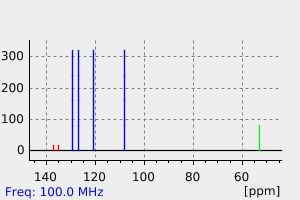1-[(4-甲基苯基)甲基]吡咯 | 94054-40-7
中文名称
1-[(4-甲基苯基)甲基]吡咯
中文别名
——
英文名称
1-(4-methylbenzyl)-1H-pyrrole
英文别名
N-(4-methylbenzyl)pyrrole;N-(p-methylbenzyl)pyrrole;1-[(4-methylphenyl)methyl]pyrrole
CAS
94054-40-7
化学式
C12H13N
mdl
MFCD12187063
分子量
171.242
InChiKey
BKMDGFGFVPFAEA-UHFFFAOYSA-N
BEILSTEIN
——
EINECS
——
-
物化性质
-
计算性质
-
ADMET
-
安全信息
-
SDS
-
制备方法与用途
-
上下游信息
-
文献信息
-
表征谱图
-
同类化合物
-
相关功能分类
-
相关结构分类
计算性质
-
辛醇/水分配系数(LogP):3.1
-
重原子数:13
-
可旋转键数:2
-
环数:2.0
-
sp3杂化的碳原子比例:0.166
-
拓扑面积:4.9
-
氢给体数:0
-
氢受体数:0
SDS
反应信息
-
作为反应物:描述:1-[(4-甲基苯基)甲基]吡咯 、 1-allyl-3-diazoindolin-2-one 在 dirhodium tetraacetate 作用下, 以 二氯甲烷 为溶剂, 反应 5.0h, 以69%的产率得到3-[1-[(4-methylphenyl)methyl]pyrrol-2-yl]-1-prop-2-enyl-3H-indol-2-one参考文献:名称:Rh2(OAc)4-Catalyzed Regioselective Intermolecular C-H Insertion Reactions: Novel Synthesis of 2-Pyrrol-3′-yloxindoles摘要:在乙酸铑(II)催化剂存在下,环重氮羰基化合物 1a-e 与吡咯和取代吡咯(2a-d)通过分子间 C-H 插入反应,实现了 2-吡咯-3′-yloxindoles 的区域选择性合成。DOI:10.1055/s-2002-34889
-
作为产物:描述:(4-甲基苯基)甲醇 在 hydrazine hydrate 、 三溴化磷 、 caesium carbonate 作用下, 以 甲醇 、 二氯甲烷 、 甲苯 为溶剂, 反应 36.5h, 生成 1-[(4-甲基苯基)甲基]吡咯参考文献:名称:单原子钴催化叠氮化物转移氢化及吡咯一锅法合成摘要:在这项工作中,报道了在温和条件下(30°C,30 分钟)使用 NH 2 NH 2 ⋅ H 2 O 作为氢源,单原子钴催化叠氮化物的转移氢化(TH)。采用该方案,多种叠氮化物被转化为其相应的胺。该方法被扩展到以一锅法从叠氮化物合成几种重要的N-取代吡咯。对照实验表明,吸电子取代基有利于转移氢化,给电子取代基有利于一锅吡咯合成。可回收性测试表明,催化剂可回收最多 7次,催化活性没有明显损失。DOI:10.1002/adsc.202300556
文献信息
-
Synthesis and nuclear magnetic resonance spectroscopic studies of 1-arylpyrroles作者:Chang Kiu Lee、Jung Ho Jun、Ji Sook YuDOI:10.1002/jhet.5570370104日期:2000.1A series of m- and p-substituted 1-phenyl, 1-benzyl, 1-benzoyl, and 1-(2-phenylethyl)pyrroles was prepared and their 1H and 13C nmr spectroscopic characteristics were examined. In general, good correlations were observed between the chemical shift values of the βH and the βC of pyrroles [except 1-(2-phenylethyl)pyrroles] and the Hammettt σ. The observation may be explained in terms of the electronic
-
Decarboxylative formation of N-alkyl pyrroles from 4-hydroxyproline
-
Visible light dye-photosensitised oxidation of pyrroles using a simple LED photoreactor作者:James K. Howard、Kieran J. Rihak、Christopher J. T. Hyland、Alex C. Bissember、Jason A. SmithDOI:10.1039/c6ob01719c日期:——The photooxidation of pyrrole is typically low yielding due to the absorbance of ultraviolet light, which leads to uncontrolled polymerisation and decomposition. Presented herein is the development of a simple and cost-effective photoreactor utilising Light Emitting Diodes (LEDs) as the light source, and its application to the dye-sensitised oxidation of a range of pyrroles to give corresponding 3-pyrrolin-2-ones
-
Sustainable Pathways to Pyrroles through Iron-Catalyzed<i>N</i>-Heterocyclization from Unsaturated Diols and Primary Amines作者:Tao Yan、Katalin BartaDOI:10.1002/cssc.201600607日期:2016.9.8pharmaceutically active compounds and play an important role in medicinal chemistry. Therefore, the development of new, atom‐economic, and sustainable catalytic strategies to obtain these moieties is highly desired. Direct catalytic pathways that utilize readily available alcohol substrates have been recently established; however, these approaches rely on the use of noble metals such as ruthenium or iridium
-
Novel carbapenem compound申请人:Sunagawa Makoto公开号:US20090029964A1公开(公告)日:2009-01-29An orally administrable antibacterial agent which contains as an active ingredient a carbapenem compound represented by the formula [1] below, wherein R 0 represents hydrogen atom or the like; R 1 represents C 1 -C 3 alkyl substituted by hydroxyl group or the like; R represents hydrogen atom or a group which regenerates a carboxyl group by hydrolysis in a living body; L represents a single bond, methylene, —OCH 2 (CO)— or the like; and Het represents a group represented by the following formula [2], wherein m and n independently represent 0 or 1; A and B independently represent methylene, carbonyl or the like; Y represents methylene, ethylene, oxygen atom, —OCH 2 —, —NR a CH 2 — (wherein R a represents hydrogen atom, optionally substituted C 1 -C 4 alkyl group or the like) or the like.
表征谱图
-
氢谱1HNMR
-
质谱MS
-
碳谱13CNMR
-
红外IR
-
拉曼Raman
-
峰位数据
-
峰位匹配
-
表征信息
同类化合物
(βS)-β-氨基-4-(4-羟基苯氧基)-3,5-二碘苯甲丙醇
(S,S)-邻甲苯基-DIPAMP
(S)-(-)-7'-〔4(S)-(苄基)恶唑-2-基]-7-二(3,5-二-叔丁基苯基)膦基-2,2',3,3'-四氢-1,1-螺二氢茚
(S)-盐酸沙丁胺醇
(S)-3-(叔丁基)-4-(2,6-二甲氧基苯基)-2,3-二氢苯并[d][1,3]氧磷杂环戊二烯
(S)-2,2'-双[双(3,5-三氟甲基苯基)膦基]-4,4',6,6'-四甲氧基联苯
(S)-1-[3,5-双(三氟甲基)苯基]-3-[1-(二甲基氨基)-3-甲基丁烷-2-基]硫脲
(R)富马酸托特罗定
(R)-(-)-盐酸尼古地平
(R)-(-)-4,12-双(二苯基膦基)[2.2]对环芳烷(1,5环辛二烯)铑(I)四氟硼酸盐
(R)-(+)-7-双(3,5-二叔丁基苯基)膦基7''-[((6-甲基吡啶-2-基甲基)氨基]-2,2'',3,3''-四氢-1,1''-螺双茚满
(R)-(+)-7-双(3,5-二叔丁基苯基)膦基7''-[(4-叔丁基吡啶-2-基甲基)氨基]-2,2'',3,3''-四氢-1,1''-螺双茚满
(R)-(+)-7-双(3,5-二叔丁基苯基)膦基7''-[(3-甲基吡啶-2-基甲基)氨基]-2,2'',3,3''-四氢-1,1''-螺双茚满
(R)-(+)-4,7-双(3,5-二-叔丁基苯基)膦基-7“-[(吡啶-2-基甲基)氨基]-2,2”,3,3'-四氢1,1'-螺二茚满
(R)-3-(叔丁基)-4-(2,6-二苯氧基苯基)-2,3-二氢苯并[d][1,3]氧杂磷杂环戊烯
(R)-2-[((二苯基膦基)甲基]吡咯烷
(R)-1-[3,5-双(三氟甲基)苯基]-3-[1-(二甲基氨基)-3-甲基丁烷-2-基]硫脲
(N-(4-甲氧基苯基)-N-甲基-3-(1-哌啶基)丙-2-烯酰胺)
(5-溴-2-羟基苯基)-4-氯苯甲酮
(5-溴-2-氯苯基)(4-羟基苯基)甲酮
(5-氧代-3-苯基-2,5-二氢-1,2,3,4-oxatriazol-3-鎓)
(4S,5R)-4-甲基-5-苯基-1,2,3-氧代噻唑烷-2,2-二氧化物-3-羧酸叔丁酯
(4S,4''S)-2,2''-亚环戊基双[4,5-二氢-4-(苯甲基)恶唑]
(4-溴苯基)-[2-氟-4-[6-[甲基(丙-2-烯基)氨基]己氧基]苯基]甲酮
(4-丁氧基苯甲基)三苯基溴化磷
(3aR,8aR)-(-)-4,4,8,8-四(3,5-二甲基苯基)四氢-2,2-二甲基-6-苯基-1,3-二氧戊环[4,5-e]二恶唑磷
(3aR,6aS)-5-氧代六氢环戊基[c]吡咯-2(1H)-羧酸酯
(2Z)-3-[[(4-氯苯基)氨基]-2-氰基丙烯酸乙酯
(2S,3S,5S)-5-(叔丁氧基甲酰氨基)-2-(N-5-噻唑基-甲氧羰基)氨基-1,6-二苯基-3-羟基己烷
(2S,2''S,3S,3''S)-3,3''-二叔丁基-4,4''-双(2,6-二甲氧基苯基)-2,2'',3,3''-四氢-2,2''-联苯并[d][1,3]氧杂磷杂戊环
(2S)-(-)-2-{[[[[3,5-双(氟代甲基)苯基]氨基]硫代甲基]氨基}-N-(二苯基甲基)-N,3,3-三甲基丁酰胺
(2S)-2-[[[[[((1S,2S)-2-氨基环己基]氨基]硫代甲基]氨基]-N-(二苯甲基)-N,3,3-三甲基丁酰胺
(2S)-2-[[[[[[((1R,2R)-2-氨基环己基]氨基]硫代甲基]氨基]-N-(二苯甲基)-N,3,3-三甲基丁酰胺
(2-硝基苯基)磷酸三酰胺
(2,6-二氯苯基)乙酰氯
(2,3-二甲氧基-5-甲基苯基)硼酸
(1S,2S,3S,5S)-5-叠氮基-3-(苯基甲氧基)-2-[(苯基甲氧基)甲基]环戊醇
(1S,2S,3R,5R)-2-(苄氧基)甲基-6-氧杂双环[3.1.0]己-3-醇
(1-(4-氟苯基)环丙基)甲胺盐酸盐
(1-(3-溴苯基)环丁基)甲胺盐酸盐
(1-(2-氯苯基)环丁基)甲胺盐酸盐
(1-(2-氟苯基)环丙基)甲胺盐酸盐
(1-(2,6-二氟苯基)环丙基)甲胺盐酸盐
(-)-去甲基西布曲明
龙蒿油
龙胆酸钠
龙胆酸叔丁酯
龙胆酸
龙胆紫-d6
龙胆紫







